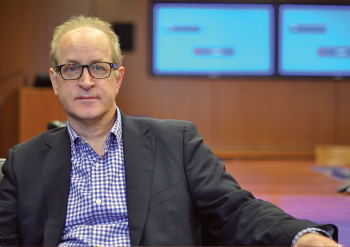When Gillette acquired the high-end merchandise brand The Art of Shaving in 2010, the firm asked BBDO’s Cultural Discoveries insight group for help in getting to know a segment of men who were very different from the typical customer.

Photo by Janet Sassi
“They wanted us to study men who liked shaving. This segment seemed to defy the whole product category,” said the research team’s leader, Timothy de Waal Malefyt, Ph.D., associate professor of marketing at the Fordham Schools of Business. “Most of this target group disliked shaving altogether—a consumer category that was notorious for low involvement.”
Malefyt, a corporate anthropologist, set out to conduct ethnographic research on the shaving enthusiasts devoted to this premium-priced product line.
His work on behalf of BBDO and Gillette has inspired Malefyt’s long-term interest in brand rituals. The topic is the focus of his latest research and a chapter he authored in the soon-to-be-published Handbook of Anthropology in Business (Left Coast Press, 2014).
Not only did the shaving enthusiasts care about their appearance, Malefyt discovered, but they also greatly enjoyed their daily grooming routine—unlike their counterparts who simply wanted to get the job done. The Art of Shaving’s four-step process—pre-shave, lathering, shaving, and aftershave, complete with lathering brushes, premium blades, oils and fragrances—offered them a full experience that engages the senses.
“From this research we learned that brand rituals that involve process and effort can be something that celebrates the user and helps to develop skills they can share with other users,” he said.
In discussing what they liked about The Art of Shaving, the men interviewed talked about the fragrances, the skill of holding the razor at the right angle, and the types of blades they used—“all these sensory dimensions to shaving that most men never talked about.”
Malefyt said there are other brands that capture a similar sense of ritual and that are experiential, engaging, and sensorial. American Girl dolls are one example, in that girls can order a customized doll with their own features, they can get their hair cut and shampooed like their dolls, wear the same clothing, and learn about the history of period dolls through the book series. “There’s much more of a sense of involvement and a depth of experience with this brand than, say, a Barbie that you purchase at Wal-Mart.”
Wine clubs are another example of ritualistic, experiential brands. People learn new descriptors for expressing flavor bouquets and how to differentiate them. Each month, wine club members taste new wines and learn about the regions they are from and what foods pair well with them.
“The development of skills in rituals makes people feel that they own the brand,” Malefyt said. “They identify with it and talk about it with others. There’s a sense of community around that.”
Malefyt is among a niche of professionals who study business anthropology, a field that informs industries about how buyers are influenced by culture and human relationships. By studying consumer behaviors and shopping habits, business anthropologists help marketers better understand consumers’ needs and expectations.
“People think of anthropology as going off to study a tribe in Borneo,” said Malefyt. “Now, the world is fully developed and explored, but what has survived in anthropology are the tools to understand people from another point of view. That is really powerful.”
Malefyt’s research on consumer marketing is wide ranging, and includes specific types of purchasing experiences, such as consumer shopping habits in the grocery store. To illustrate how business anthropology can help to inform marketing strategies, he cites floor-cleaning products. Why consumers choose one cleaner over another may have less to do with the product itself and far more to do with individual ideas and relationships. Is the product environmentally friendly? Will a toddler crawl on the floor? Does a sparkling floor symbolize something you’d want guests to perceive about you? He says purchases and brand selection are more emotionally charged than we think.
Today, advertising is also more personal and sophisticated, Malefyt said. “Brands are not logos, they are experiences. Brands like American Girl, The Art of Shaving, Disney Vacations, and others create dialogue with the consumer rather than talk to them. But conversations require more social understanding of where the consumers are coming from, and that’s where anthropologists and sociologists can help out.”
In addition to leading the ethnographic unit at BBDO Worldwide, Malefyt is the recipient of a National Science Foundation grant and a Fulbright fellowship in Spain. He has published widely and is co-author of the book Advertising and Anthropology: Ethnographic Practice and Cultural Perspectives (Berg, 2012). He holds a doctorate in cultural anthropology, and was a dancer with the Joffrey Ballet until a knee injury shifted his career path.
Malefyt is also involved in planning EPIC (Ethnographic Praxis in Industry Conference), which will bring together professionals from different disciplines around the world to discuss the multifaceted field of marketing. Sponsored by Fordham’s Center for Positive Marketing, the conference will be held at Fordham from Sept. 7 through 10, 2014.
